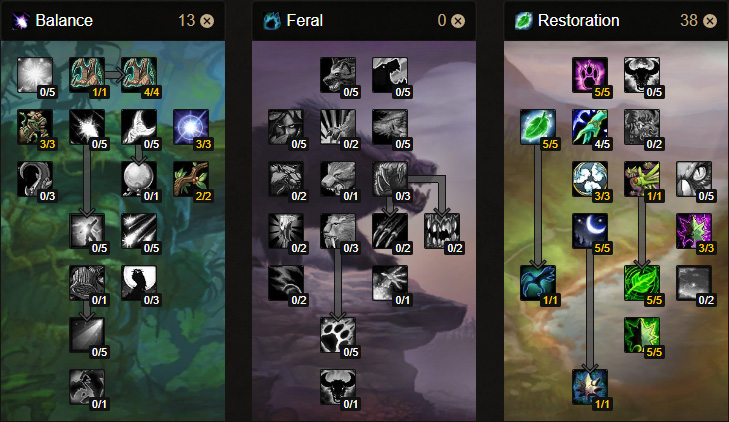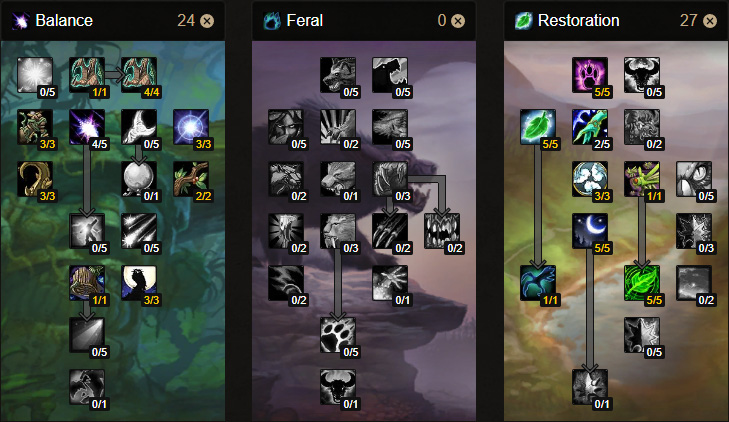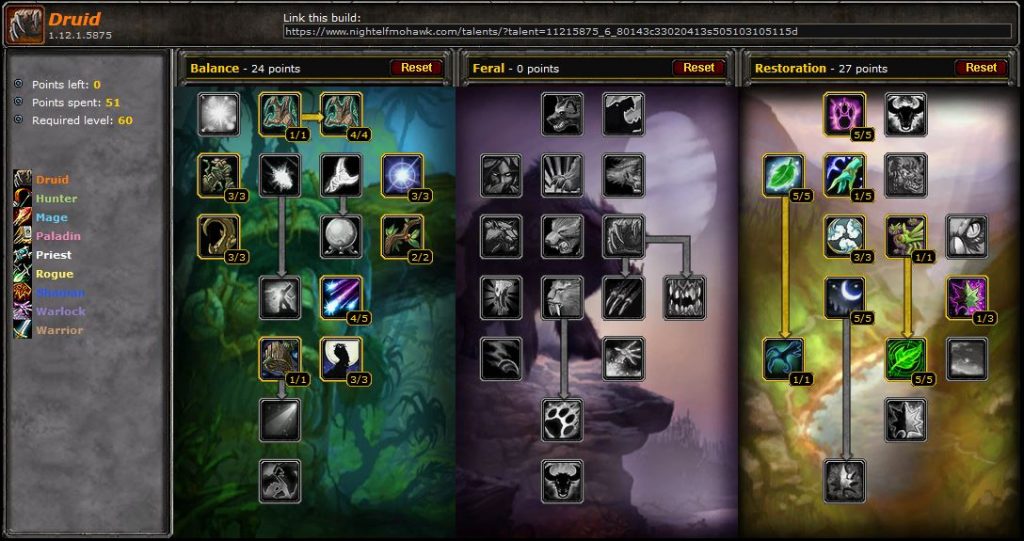- Author: Furious
- Date: December 3, 2018
- Updated: June 19, 2023
- Expansion: WoW Classic
Welcome to our WoW Classic guide for Restoration Druids! Druids are the most versatile class in the entire game, using their shapeshifting ability to harness the powers of whatever role they so desire. Druids have the ability to deal damage either up close in Cat Form or with spells from afar in Moonkin Form. They can also switch to Bear Form and serve as a tank, or stay in their traditional humanoid form to heal with the Restoration talent tree.
While druids can be anything they want, their best role in a raiding environment is undoubtedly using the restorative power of nature to heal and restore their allies. In this guide we’ll cover all you need to know about playing a Restoration Druid! We’ll start with the two race options and then cover the best talent tree builds to use. After that, we’ll explain everything that goes into optimizing your Restoration Druid! From stat priorities to enchants, we’ll cover it all! To finish things off, we’ll give you a rundown of how you should play in a raiding environment!
Races
Druids are a fairly restrictive class, only being available to the two races that are closely in tune with nature. Both Alliance and Horde have one option when it comes to race. Alliance players can choose a night elf, while Horde players can play as a tauren. Both races are fairly identical in terms of power, considering neither offer any racial bonuses that benefit a Restoration Druid. If you want to see what both races offer, check it out here!
- Alliance – Night Elf
- Horde – Tauren
Talents
When it comes to picking your talents, Restoration Druids have a bit of flexibility. Your build will ultimately depend on your healing role within your raid. If you’re focused on tank healing (or just starting out as a healer), you’ll definitely want to use a deep Restoration Swiftmend build. If you’re assigned to raid healing, a hybrid Balance build focusing on reducing mana costs is a better option.

This deep Restoration build is fantastic for just about any setting. The only time you’ll really struggle is if you are the only healer assigned to raid healing. Fortunately, that doesn’t happen often, so you can’t go wrong with a 13/0/38 build. This picks up the most important ability, Swiftmend, which will consume a heal-over-time effect you have on a target to instantly heal them for the amount of a full-duration Rejuvenation or Regrowth. Not only that, but you have 3 points in Improved Rejuvenation for an extra 15% effectiveness on one of your easiest heals.

In the event that you are assigned to raid healing, you’ll have an easier time if you choose to drop Swiftmend altogether. This build focuses on the Balance talents Nature’s Grace, which reduces spell casting time by 0.5 seconds following a spell critical strike, and Moonglow, which lowers the mana cost of Healing Touch, Regrowth, and Rejuvenation. This allows you to cast more heals overall, while also casting them quicker if you manage to crit. You’ll mainly use Healing Touch and Rejuvenation with this build.
Optimization
Taking the time to optimize your Restoration Druid is well worth it. Not only will you allow yourself to restore more health with each heal, but you’ll also extend the duration in which you can effectively heal. Failing to optimize your Restoration Druid will quickly put you out-of-mana during high intensity raid encounters. Healers without mana are completely useless, so you’ll need to optimize to keep your raid spot!
Stat Priority
Restoration Druids have several helpful stats available to them, but a few are more valuable than others. The theorycrafting behind stat priorities for any healer also applies to a Restoration Druid. Your primary focus is to boost the power of your heals, but you’ll also want plenty of mana and regeneration to allow you to keep pumping out those heals.
With that in mind, prioritize these stats for a Restoration Druid:
- Healing Power – The absolute best stat for a Restoration Druid. Just like how Spell Power increases the damage of your spells, Healing Power boosts the restoration of your heals. Rather than restoring 500 health with a heal, Healing Power will increase it to 515 or more depending on how much you have.
- Intellect – After loading up on Healing Power, you can benefit from Intellect. Intellect will boost your overall mana pool at the rate of 15 mana per point of Intellect. You’ll also get a little of spell crit for each point of Intellect, so this is a doubly-effective stat.
- Spirit – Spirit is a fantastic stat for Restoration Druids. It is almost as important as Intellect, but without a mana pool to draw from, regeneration won’t have an effect. Thanks to 3 points in the Reflection talent, 15% of your mana regen will continue during combat.
- Mana per 5 (MP5) – You can also benefit from traditional MP5. Mana regeneration is always helpful for a healer, but Spirit is just a little more effective for Restoration Druids. Don’t let that stop you from using it!
- Critical Strike Rating – The lowest priority on your list is Critical Strike rating. You’re not a damage dealer, meaning it isn’t your goal to “heal” as much as possible. Instead, you’re trying to find a good balance between mana and casting heals. Crit is always nice to have, but don’t prioritize it.
Professions
One thing that often gets overlooked for any class is the use of professions. While professions may not always have a direct offensive bonus, they offer several ways of making money and providing indirect benefits. For example, some consumables are made through professions, but they can be traded. Taking the profession needed to craft consumables doesn’t give you a leg up on anyone, but it does give you better access to them. This makes you much more likely to take advantage of them.
You’ll want these professions for a Restoration Druid:
- Alchemy – Alchemy is one of those professions that can create consumables. Alchemy is responsible for crafting flasks, elixirs, and potions, all of which make up some of the strongest consumables you can use. Considering the constant battle you’ll have with mana, this is one great way to get a permanent advantage.
- Herbalism – To pair with Alchemy, you’ll want Herbalism so you can actually gather the required herbs for those tasty flasks, elixirs, and potions. Not only that, but tauren in particular have an added +15 boost to Herbalism thanks to racial bonuses.
- Engineering – If you don’t want to turn into a potion machine, you can also pick up engineering. Engineering is the most popular profession in the game thanks to the use of bombs and gadgets. You won’t benefit as much as a healer, but it is still an excellent choice.
- Mining – If you’re going to be an engineer, take Mining. Engineering requires metal ore and stone, which are found through Mining!
Enchants
Enchants are definitely one of the most important parts of optimizing. As a Restoration Druid, you can enchant 9 pieces of equipment that will result in a substantial increase to your overall healing power. Considering Healing Power is your most important stat, the bonuses you get from enchants are well worth their expensive price tag!
Pick up these enchants for your Restoration Druid:
- Helm – Animist’s Caress, +24 Healing Power, +10 Intellect, +10 Stamina or Arcanum of Focus, +8 Spell/Healing Power
- Shoulder – Zandalar Signet of Serenity, +33 Healing Power
- Cloak – Subtlety, -2% Threat, or Greater Resistance, +5 All Resistances
- Chest – Greater Stats, +4 All Stats
- Bracers – Healing, +24 Healing Power or Greater Intellect, +7 Intellect
- Gloves – Healing Power, +30 Healing Power
- Pants – Animist’s Caress, +24 Healing Power, +10 Intellect, +10 Stamina or Arcanum of Focus, +8 Spell/Healing Power
- Boots – Minor Speed, + Movement Speed
- Weapon – Healing Power, +55 Healing Power or Intellect, +22 Intellect
Consumables
Another important thing for a Restoration Druid to consider is the collection of consumables. Consumables are quite important for a Restoration Druid considering they’ll mainly provide you with mana support. The ability to keep your mana afloat is crucial for any healer, so anything that gives you an edge in that department is well worth the farming time!
Restoration Druids will want all of these consumables:
- Elixirs – Flask of Distilled Wisdom, +2000 Mana for 2 hours
- Potions – Mageblood Potion, +12 MP5 for 1 hour and Major Mana Potion, ~1800 mana every 2 minutes.
- Food – Nightfin Soup, +8 MP5 or Sagefish Delight, +6 MP5
- Weapon Oil – Brilliant Mana Oil, +25 Healing Power and +12 MP5 for 30 minutes
- Others – Scroll of Intellect / Spirit will give an extra +17 of either stat, and Demonic / Dark Rune will grant mana at the cost of health
Rotation & Gameplay Tips
Restoration Druids are some of the best healers in the game, thanks to powerful heal-over-time effects and useful direct heals. While druids serve best as a tank healer, they’re also great at keeping raids alive by applying Rejuvenation to raid members in danger. How you end up playing will ultimately depend on your role as a healer, but there are still important concepts to know that apply to either role!
Here are some gameplay tips for a Restoration Druid:
- Three extremely important cooldowns a Restoration Druid has are Rebirth, which is actually an in-combat resurrection on a 30 minute cooldown, Tranquility, a channeled heal for all nearby group members on a 5 minute cooldown, and Innervate, which greatly boosts a targets mana regeneration on a 6 minute cooldown.
- You’ll want to save Rebirth only for when a tank dies on a serious boss attempt. Tranquility is a great emergency heal if your whole party is in danger of dying. Things get trickier with Innervate, considering that you can use it on another target. You’ll have to decide if more mana or higher damage output from a spell caster is more important. If you’re having a hard time killing bosses due to mana issues, use it on a healer.
- One final cooldown you can use is Nature’s Swiftness, which makes your next nature spell an instant cast with a 3 minute cooldown. You can use this to cast an instant Rebirth battle-rez, or you can also use it with a max rank Healing Touch for an instant massive heal.
- Druids have access to a buff, Mark of the Wild, which boosts armor by 285, all attributed by 12, and all resistances by 20. Keep this applied at all times!
- Druids also have a critical debuff that is worth one of the 16 slots, Faerie Fire. Faerie Fire is a unique debuff that reduces a target’s armor by 505. This is different from Sunder Armor from a warrior, and can only be applied by druids.
- Don’t be afraid to make use of Abolish Poison in case of harmful poison effects. Not only does it remove one effect upon cast, but it will also attempt to remove one every other second for the next 8 seconds. You can also use Remove Curse to get rid of curse effects!
- One thing you’ll want to consider doing is downranking your spells. As your spells get higher in rank, they heal for more with each cast. At the same time, they often come with a more expensive mana cost. Many times it is actually more efficient to use a lower rank of a healing spell despite healing less overall. If you don’t necessarily require a big heal, consider using a lower rank (1 or 2 should be fine for a Restoration Druid’s main heals) to help keep your mana bar fuller.
- If you’re in danger of dying and can’t heal yourself quick enough, don’t be afraid to make use of Bear Form! You can switch into Bear Form and immediately cast Enrage so you can make use of Frenzied Regeneration to try and keep yourself alive. Shapeshifting also gets rid of any polymorph or slow effects, while Bear Form in particular makes you especially tanky.
- If your tank isn’t taking a ton of damage and you have plenty of mana, feel free to toss out Rejuvenation on raid members that are low on health. Regrowth is also an option if someone is in danger, but this puts you at risk of not being available to start a Healing Touch on your tank. Cast Regrowth only if you know your tank isn’t in danger for a while to come!
When it comes to healing as a Restoration Druid, your rotation will ultimately depend on whether you need to focus on the tank or the whole raid. You follow less of a rotation in both situations, but instead choose your spells based on what is most effective for each particular scenario.
If you’re assigned as a tank healer, you’ll primarily want to use a rank 3 Healing Touch as your primarily healing spell. It has a 0.5 second quicker cast than rank 4 and is extremely mana efficient. If tank damage is a little heavy, you can also keep a max rank Rejuvenation applied at all times. Don’t refresh it until it falls off.
You can also use a cast of rank 3 Regrowth to apply the heal-over-time effect. You won’t want to spam this because it is quite mana-costly. After casting it once, go back to using rank 3 (or 4) Healing Touch.
If tank damage is extremely high, immediately cast Swiftmend, followed by rank 5 Regrowth until you feel comfortable enough to throw a Rejuvenation up. After that, you can go back to using rank 3 of Healing Touch until Regrowth is required again or Rejuvenation falls off.
To simplify:
- Swiftmend Tank Build
- Low Damage: Healing Touch (rank 3)
- Medium Damage: Keep Rejuvenation (rank 11) applied > Regrowth (rank 3) > Healing Touch (rank 3)
- High Damage: Swiftmend > Regrowth (rank 5) > Rejuvenation (rank 11) applied > Healing Touch (rank 3)
Raid healing is a little different, especially considering that you won’t have the Swiftmend ability. As a raid healer, your job now is instead to keep everyone alive rather than just one person. If raid damage is fairly low, you can probably get away with casting just rank 11 Rejuvenation on individual targets taking damage.
If damage output is more intense, you can use rank 3 Regrowth on targets to heal a little bit immediately while also applying your heal-over-time. If raid damage is really intense, you can use procs from the Nature’s Grace talent to help you cast a high rank of Healing Touch on the most dire raid member, switching back to rank 3 Healing Touch on other targets to preserve your mana.
To simplify:
- Raid Healing Build
- Low Damage: Rejuvenation (rank 11)
- Medium Damage: Regrowth (rank 3) > Rejuvenation (rank 11)
- High Damage: Healing Touch (rank 11 w/ Nature’s Grace) > Healing Touch (rank 3) > Regrowth (rank 3)


